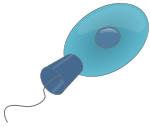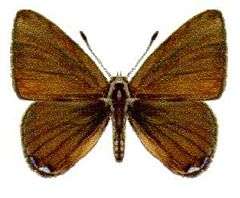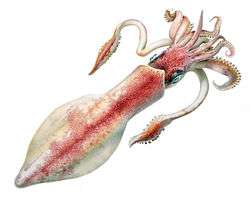ParaHoxozoa
The ParaHoxozoa are a proposed basal Diploblast/Eumetazoa clade as sister of the Ctenophora. It consists of the Triploblasts/Bilateria as well as the Placozoa and Cnidaria.[1][2][3][4][5][6][7]
| ParaHoxozoa | |
|---|---|
| Scientific classification | |
| (unranked): | Unikonta |
| (unranked): | Obazoa |
| (unranked): | Opisthokonta |
| (unranked): | Holozoa |
| (unranked): | Filozoa |
| Kingdom: | Animalia |
| Subkingdom: | Eumetazoa |
| Clade: | ParaHoxozoa Ryan et al., 2010 |
| Clades | |
Characteristics
The Parahoxozoa group was defined based on the presence of several gene (sub)classes (HNF, CUT, PROS, ZF, CERS, K50, S50-PRD), as well as Hox/ParaHox-ANTP from which the name of this clade originated. It was later proposed[8][9] and contested[10] that a gene of the same class (ANTP) as the Hox/ParaHox, the NK gene and the Cdx Parahox gene, is also present in Porifera. Nevertheless, the Parahoxozoa as originally defined without Porifera may be a monophyletic clade, and is continued to be used as such.[4]
| Choanozoa |
| ||||||||||||||||||||||||||||||||||||||||||||||||
| (950 mya) |
The position of Placozoa is not clear, as it may be sister the remaining Parahoxozoa (the Planulozoa hypothesis) or sister to the Cnidaria.
Planula-acoel, triploblasty, and bilaterian similarities
The original bilateria are hypothesized to be a bottom dwelling worm with a single body opening.[11] A through-gut may already have developed with the ctenophora however.[12] The through-gut may have developed from the corners of a single opening with lips fusing. E.g. Acoela resemble the planula larvae of some cnidaria, which exhibit some bilaterian symmetry. They are vermiformes, just as the cnidarian Buddenbrockia is.[13][14][15] Placozoa has been noted to resemble planula.[16] Usually, "Planulozoa" is to the exclusion of Placozoa, but not necessarily. In this case it appears synonymous with ParaHoxozoa.[17] Triploblasty developed before the Cnidara-Bilateria radiation as well.[18]
References
- Feuda, Roberto; Dohrmann, Martin; Pett, Walker; Philippe, Hervé; Rota-Stabelli, Omar; Lartillot, Nicolas; Wörheide, Gert; Pisani, Davide (2017). "Improved Modeling of Compositional Heterogeneity Supports Sponges as Sister to All Other Animals". Current Biology. 6 (24): 3864–3870.e4. doi:10.1016/j.cub.2017.11.008. PMID 29199080.
- Pisani, Davide; Pett, Walker; Dohrmann, Martin; Feuda, Roberto; Rota-Stabelli, Omar; Philippe, Hervé; Lartillot, Nicolas; Wörheide, Gert (15 December 2015). "Genomic data do not support comb jellies as the sister group to all other animals". Proceedings of the National Academy of Sciences. 112 (50): 15402–15407. Bibcode:2015PNAS..11215402P. doi:10.1073/pnas.1518127112. ISSN 0027-8424. PMC 4687580. PMID 26621703.
- Simion, Paul; Philippe, Hervé; Baurain, Denis; Jager, Muriel; Richter, Daniel J.; Franco, Arnaud Di; Roure, Béatrice; Satoh, Nori; Quéinnec, Éric (3 April 2017). "A Large and Consistent Phylogenomic Dataset Supports Sponges as the Sister Group to All Other Animals" (PDF). Current Biology (Submitted manuscript). 27 (7): 958–967. doi:10.1016/j.cub.2017.02.031. ISSN 0960-9822. PMID 28318975.
- Giribet, Gonzalo (1 October 2016). "Genomics and the animal tree of life: conflicts and future prospects". Zoologica Scripta. 45: 14–21. doi:10.1111/zsc.12215. ISSN 1463-6409.
- Laumer, Christopher E; Gruber-Vodicka, Harald; Hadfield, Michael G; Pearse, Vicki B; Riesgo, Ana; Marioni, John C; Giribet, Gonzalo (2018-10-30). "Support for a clade of Placozoa and Cnidaria in genes with minimal compositional bias". eLife. 7. doi:10.7554/elife.36278. ISSN 2050-084X. PMC 6277202. PMID 30373720.
- Ryan, Joseph F.; Pang, Kevin; Mullikin, James C.; Martindale, Mark Q.; Baxevanis, Andreas D. (2010-10-04). "The homeodomain complement of the ctenophore Mnemiopsis leidyi suggests that Ctenophora and Porifera diverged prior to the ParaHoxozoa". EvoDevo. 1 (1): 9. doi:10.1186/2041-9139-1-9. ISSN 2041-9139. PMC 2959044. PMID 20920347.
- Eitel, Michael; Francis, Warren; Osigus, Hans-Jürgen; Krebs, Stefan; Vargas, Sergio; Blum, Helmut; Williams, Gray Argust; Schierwater, Bernd; Wörheide, Gert (2017-10-13). "A taxogenomics approach uncovers a new genus in the phylum Placozoa". bioRxiv: 202119. doi:10.1101/202119.
- Fortunato, Sofia A. V.; Adamski, Marcin; Ramos, Olivia Mendivil; Leininger, Sven; Liu, Jing; Ferrier, David E. K.; Adamska, Maja (2014-10-30). "Calcisponges have a ParaHox gene and dynamic expression of dispersed NK homeobox genes". Nature. 514 (7524): 620–623. Bibcode:2014Natur.514..620F. doi:10.1038/nature13881. hdl:10023/6597. ISSN 0028-0836. PMID 25355364.
- Larroux, Claire; Fahey, Bryony; Degnan, Sandie M.; Adamski, Marcin; Rokhsar, Daniel S.; Degnan, Bernard M. (1996). "The NK Homeobox Gene Cluster Predates the Origin of Hox Genes". Current Biology. 17 (8): 706–710. doi:10.1016/j.cub.2007.03.008. PMID 17379523.
- Ryan, Joseph F.; DeBiasse, Melissa B.; Pastrana, Claudia C. (2019). "Sponges lack ParaHox genes". Genome Biology and Evolution. 11 (4): 1250–1257. doi:10.1093/gbe/evz052. PMC 6486804. PMID 30859199.
- Cannon, Johanna Taylor; Vellutini, Bruno Cossermelli; Smith, Julian; Ronquist, Fredrik; Jondelius, Ulf; Hejnol, Andreas (2016). "Xenacoelomorpha is the sister group to Nephrozoa". Nature (Submitted manuscript). 530 (7588): 89–93. Bibcode:2016Natur.530...89C. doi:10.1038/nature16520. PMID 26842059.
- Browne, William E.; Amemiya, Chris T.; Swalla, Billie J.; Warren, Kaitlyn J.; Vandepas, Lauren E.; Presnell, Jason S. (2016-10-24). "The Presence of a Functionally Tripartite Through-Gut in Ctenophora Has Implications for Metazoan Character Trait Evolution". Current Biology. 26 (20): 2814–2820. doi:10.1016/j.cub.2016.08.019. ISSN 0960-9822. PMID 27568594.
- Jiménez-Guri, Eva; Philippe, Hervé; Okamura, Beth; Holland, Peter W. H. (2007-07-06). "Buddenbrockia Is a Cnidarian Worm". Science. 317 (5834): 116–118. Bibcode:2007Sci...317..116J. doi:10.1126/science.1142024. ISSN 0036-8075. PMID 17615357.
- Baguñà, Jaume; Martinez, Pere; Paps, Jordi; Riutort, Marta (2008-04-27). "Back in time: a new systematic proposal for the Bilateria". Philosophical Transactions of the Royal Society B: Biological Sciences. 363 (1496): 1481–1491. doi:10.1098/rstb.2007.2238. ISSN 0962-8436. PMC 2615819. PMID 18192186.
- Genikhovich, Grigory; Technau, Ulrich (2017-10-01). "On the evolution of bilaterality". Development. 144 (19): 3392–3404. doi:10.1242/dev.141507. ISSN 0950-1991. PMID 28974637.
- Syed, Tareq; Schierwater, Bernd (2002). "The evolution of the placozoa: A new morphological model". Senckenbergiana Lethaea. 82 (1): 315–324. doi:10.1007/bf03043791. ISSN 0037-2110.
- Wallberg, Andreas; Thollesson, Mikael; Farris, James S.; Jondelius, Ulf (2004). "The phylogenetic position of the comb jellies (Ctenophora) and the importance of taxonomic sampling". Cladistics. 20 (6): 558–578. doi:10.1111/j.1096-0031.2004.00041.x. ISSN 0748-3007.
- Boero, F.; Schierwater, B.; Piraino, S. (2007-06-01). "Cnidarian milestones in metazoan evolution". Integrative and Comparative Biology. 47 (5): 693–700. doi:10.1093/icb/icm041. ISSN 1540-7063. PMID 21669750.



